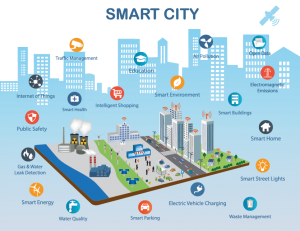The 5G SOLUTIONS project



Dr. Per Jonny Nesse
Telenor Research

Håkon Lønsethagen
Telenor Research
In 2050, two thirds of the world’s population will live in cities, according to the United Nations [1]. In order for cities to handle this growth in a sustainable way, they have to become energy efficient and climate resilient, improve mobility and healthcare, as well as become inclusive and attractive for all citizens. ICT solutions and especially 5G, the next generation communication technology, can become an important enabler for solving these challenges.
5G SOLUTION is one of eight projects under Phase 3 of the 5G-PPP, a private-public partnership initiated and funded through The European Commission Horizon 2020 programme, with the aim of supporting research and innovation within the smart city vertical along with other adjacent verticals [2]. This is a consortium of 26 European partners from academia, research centers, telecom operators, large industries and SMEs in 5G SOLUTIONS [3]. Telenor is a 5G experimental facility provider in the project leveraging the 5G-VINNI platform [4]. While the Norwegian University of Science and Technology (NTNU), Department of Mechanical and Industrial Engineering is a partner in the project addressing “Factories of the Future”, the NTNU smart sustainable cities is a cross-department and cross-disciplinary knowledge cluster and an external partner collaborating with Telenor to address “Co-creation for smart sustainable cities”.
Smart city use cases
In 5G SOLUTIONS an array of smart city use case scenarios are outlined and specified for upcoming trials and validations both technologically and business wise.
The smart city use cases outlined in 5G SOLUTIONS include:
- Smart street lighting: Electricity consumption is estimated to increase up to 80{b28ae05319d94bff0b4d65c5a9f4524dd588360f05c61ef440e1608e0a1c4144} in cities until 2030 compared to 2005 [5]. Reducing the electricity for lighting up streets and public areas is one area to become more energy efficient. Dimming or even switching on and off street lamps in low-traffic areas can be activated through sensor- or camera-monitoring persons or vehicles passing by. This will help the municipalities saving money and becoming more eco-friendly, while avoiding negative effects such as car accidents.
- Smart parking: Thirty percent of traffic in cities are looking for a parking space [6]. Smart parking solutions using 4K video cameras for real-time detection of occupancy and frequency/turnover of use of metropolitan area parking spaces will contribute to reduction of congestion and emissions, improve traffic safety, and simultaneously allow higher quality of life for the residents. This solution can also be combined with optimizing charging and electric network usage of electric cars and other electric vehicles such as buses or bikes.
- Smart buildings and campus: Internet of Things sensors can be deployed in private office buildings and public facilities to measure air quality, room occupancy, etc., reduce the energy consumption, allow for predictive maintenance, and utilize proximity lighting turning off heating or air conditioning when no one is present. 4K video cameras monitoring and automated detection of dangerous situations can help improve the physical security of the campus as well as the safety of its occupants. Understanding how buildings are used through sensors can also help with better planning of spaces and energy reduction for buildings.
- Smart harbour and ports: The Yara Birkeland fertilizer plant at port Herøya in Norway aims to have the world’s first fully electric autonomous container ship with zero emissions, replacing 40.000 diesel powered truck haulage journeys a year. 5G infrastructure will be deployed on the port premises supporting self-driving vehicles in addition to digitalizing working processes, e.g. remote VR/AR enhanced maintenance and operation, also providing a safer working environment.

Examples of smart sustainable city use case scenarios enabled through 5G technology (Source: AdobeStock)
Social innovation
In addition to these four vertical use cases, a new cross-cutting case for smart cities co-creation will be designed around social innovation. This will entail, amongst others, virtual and distributed co-creation between citizens and professional stakeholders and decision makers, supported by reliable live visual distribution and interactive communication with multiple remote areas, the use of digital twins, the exploration of sensor deployment, support for citizen science, and mixed reality media.
All the use case scenarios can be realized through support from 5G technology with higher data rate and lower latency, as well as massive machine-type communication such as connecting high numbers of sensors and IoT devices. A precondition is that the smart city ecosystems of partners and stakeholders are present, starting with municipalities and local governments enabling collaboration with potential industry and academic partners across several sectors [7].
Business model enablement and outlook
Information from these scenarios on energy consumption and behavioural patterns, whether it is data generated by citizens, IoT sensor networks or city level data that has broad communal use and is privacy-protected, could be made available across vertical silos proposing new collaborative frameworks and business models rewarding openness, transaction and data sharing. This can enable start-ups, SMEs, NGOs and local communities to take advantage of this data and build new apps and services relevant to the wider community. Applying machine learning or artificial intelligence techniques and algorithms on these data sets can also be an important enabler for detecting cost-efficient and environmentally friendly solutions beneficial for the ecosystem players and in the end for the citizens’ well-being.
References
[1] United Nations, “The world’s cities in 2016,” 2017.
[2] 5G PPP, “5G empowering verticals,” 17 May 2020. [Online]. Available: https://5g-ppp.eu/wp-content/uploads/2016/02/BROCHURE_5PPP_BAT2_PL.pdf
[3] 5G SOLUTIONS (5G Solutions for European Cities) project –
https://www.5gsolutionsproject.eu
[4] 5G-VINNI (5G Verticals Innovation Infrastructure) project – https://www.5g-vinni.eu
[5] Worldbank.org, “LED street lighting: Unburdening our cities,” 2020.
[6] Nettavisen, “30 prosent av all bytrafikk er unødvendig,” 2017.
[7] E. Almirall, J. Wreham, C. Ratti, P. Conesa, F. Bria, A. Gaviria and A. Edmondson, “Smart Citites at the Crossroads: New Tensions in City Transformation,” California Management Review, vol. 59, no. 1, 2016.